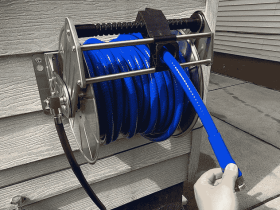If you are wondering how to polish your marble floors, this article for you. Throughout history, marble has been correlated to luxury and sophistication. Beginning with the Greek and Roman temples, palaces and saunas, to the Renaissance cathedrals and palaces until today where modern technology has made marble accessible to many homes, offices and buildings, marble continues its enduring appeal to many. However, despite its aesthetic appeal, marble floors require regular maintenance to retain their luster and pristine appearance. Foot traffic, spills, and other factors contribute to scratches, stains and overall dulling of its surface. To restore the shine and elegance of marble floors, proper care and maintenance are needed. Let this article be a comprehensive guide to show various methods for polishing marble floors, ranging from DIY techniques to professional services, along with their respective advantages and limitations.
Tips:
Before beginning to polish, it is best to keep these three things in mind.
- Identify the type of marble. Different marbles have unique needs. For instance, natural marble is colder than room temperature when touched compared to cultured marble which is almost the same as room temperature. Professional cleaners say that cultured marble is easier to clean and maintain than natural marble. In any case, both kinds of marble need the care to maintain its polish.
- Test a tiny amount of product on an inconspicuous area. This is to avoid further damage should the product be ineffective.
- Always wear gloves and eye protection when handling and using harsh chemicals.
Read more: What is TSP Cleaner & What Other Things You Should Know Before Using It.
Low-Cost Do-It-Yourself: How To Polish Marble By Hand
If you have a low budget, this marble floor polishing method is for you. You can polish your marble floor by hand in a few steps. The steps are below:
- Soak a microfiber or any non-abrasive cloth in warm water to remove visible dirt and stains on the marble floor. Let it dry.
- In a container, combine 45 grams of baking soda and 0.9 liters of water. Mix well to form a paste. Apply a thin layer of the baking soda paste to the marble floor using a clean cloth. Allow the paste to dry on the marble floor for around five hours.
- Remove the paste by using a clean cloth and warm water. Wipe the paste in circular motion, from wide circles to smaller circles, just like buffing a car, until the paste is not visible.
There are floor polishes commercially available in stores that can be easily applied if the baking soda paste is time-consuming. Choose a pH-neutral, non-abrasive cleaner designed for marble. Always remember to read and follow instructions on the package before using.
Next-Level Marble Polishing
If budget is not a problem, investing in a floor polisher can help make polishing easier and less tiring compared to manual polishing. A floor polisher can save time especially if the area to polish is large. Here are some steps to use a floor polisher on marble floors:
- Before starting, sweep or wipe off visible dirt and particles. These could scratch the marble floor’s surface.
- Choose a polishing pad suitable for marble floors. There are diamond polishing pads that are commonly used for marble because they provide excellent results without causing damage. Start with a low grit pad for initial polishing then work up to higher grit pad for finer finish.
- Attach polishing pad to the floor polisher, Make sure it is secured properly to avoid slippage during operation.
- Test the floor polisher on small area first to see the effectiveness of the polishing pad and adjust the speed and pressure as needed.
- Begin polishing the marble floor in small sections, working systematically from one corner of the room to the other. Use smooth overlapping motions to ensure even coverage and avoid streaks or unevenness.
- Maintain consistent speed and pressure. Avoid excessive pressure which may cause damage or uneven spots on the marble floor. Let the weight of the machine and the rotation of the polishing pad do the work.
- As you move around with the floor polisher, inspect the area to assess the progress of the polishing. Continue polishing until the desired level of shine and smoothness is achieved. If needed, repeat the process with a higher grit pad, as previously mentioned.
- Once finished, turn off the polisher and remove the polishing pad. To protect newly polished marble floors, consider applying a marble sealer, following the manufacturer’s instructions. Sealing the marble helps prevent staining and makes future maintenance less time-consuming.
Expert Cleaning Service
The last option and the most costly would be to get professional cleaners who are experts are polishing marble. They will know how to best treat the marble without worry of damage. They will have all the chemicals and equipment needed to restore the shine of the marble and maintain its luster.
Make the Shine Last
After you have done the polishing of marble floors, here are ways to maintain its shine:
- Wipe marble floors often with a dry cloth. Luce.sg suggests once a week if there are not a lot of foot traffic. Otherwise, every other day would be better to prevent dust particles that can scratch marble floors.
- Remove spills immediately to prevent the liquid from being absorbed by the marble. When removing spills, do not scrub, instead blot or dab gently on the spill.
- Do not use metal cleaners, lemon or vinegar to clean marble floors, because these can corrode marble.
- Consider carpets or rugs to protect marble floors from abrasive particles.
Conclusion
Carefully consider these options: homemade paste vs store-bought polish vs floor polisher vs professional marble floor polishing service. While DIY methods such as marble polishers and powder compounds offer affordability and convenience, professional services or even using a floor polisher provide superior results for more challenging issues. Always keep in mind that marble floors need the proper care in order to maintain its beauty and timelessness.











Leave a Review